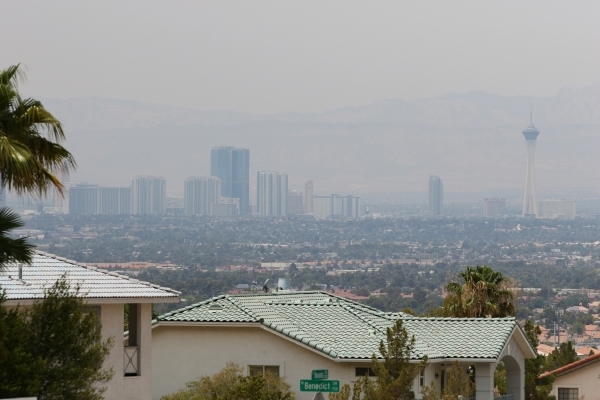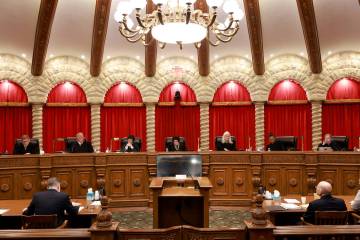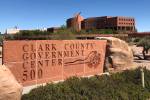New federal rules don’t hit Nevada too hard — yet
CARSON CITY — Much like a box of chocolates, you never know what you're going to get with new federal regulations, but Nevada appears to have come out mostly OK on several controversial actions this year.
Federal regulations dealing with everything from ozone and carbon dioxide emissions to water and sage grouse were all promulgated in 2014.
The new ozone limits set last week by the EPA are not as onerous as some had feared, dropping the allowable limit to 70 parts per billion from 75. Some environmental groups wanted to see a 60 ppb standard.
New carbon dioxide limits set by the EPA earlier this summer will likely prove challenging for many states, but not Nevada, where the transition from coal-fired electricity to natural gas and solar is already well underway.
The state dodged a bullet when the U.S. Fish & Wildlife Service decided not to list the greater sage grouse as threatened, which could have led to much of rural Nevada closed off to development.
Critics of the announcement argued that the decision was a Pyrrhic victory for Western states, however, since the agreement will still limit access to millions of acres in Nevada.
And Nevada was also one of several Western states that have won an initial court victory blocking a new EPA regulation that would greatly expand the scope of waters covered by the Clean Water Act.
Randi Thompson, state director of the National Federation of Independent Business, said the EPA's water regulation is her biggest concern for small business in Nevada.
"It is such an overreaching rule that will have a huge cost for a minimal positive impact," she said.
Opponents won another court victory on the issue Friday when the 6th U.S. Circuit Court of Appeals, which is based in Cincinnati, blocked the controversial Waters of the U.S. rule from taking effect nationally.
But Thompson said the other regulations could have serious consequences for Nevada as well, particularly the new ozone limit.
"This administration is regulation happy," she said. "There were 224 'economically significant' regulations issued in 2013, up over 20 percent from previous years. There are over 4,00 pending federal regulations right now."
Ozone standard impact unclear
The ozone announcement was the most recent, and prompted some concern from Gov. Brian Sandoval.
"Unfortunately, the ozone rule released today appears detrimental to certain Nevada counties and may unfairly punish our state based on factors outside of its control," he said.
U.S. Sen. Harry Reid, D-Nev., praised the new standard, but the Sierra Club expressed disappointment, wanting a lower level of 60 parts per billion.
Jane Feldman, chairwoman of the Sierra Club's Nevada Energy Task Force, said the EPA "had an opportunity to stop 7,900 premature deaths, 1.8 million childhood asthma attacks, 7,000 hospitalizations and almost 2 million missed work and school days each year by strengthening our smog standard to 60 parts per billion. They chose instead the weakest possible option — strengthening the current standard only to 70 from its current level of 75. This new standard is not adequate to protect public health, but it is progress."
Robert Tekniepe, who works in the Clark County Air Quality Planning Division, said the county is currently compliant with the 75 ppb standard. With the release of the new standard, the division will now, over the next two years, provide a comprehensive inventory to the EPA showing the emissions that lead to the formation of ozone, he said. A primary source is vehicle emissions. With that submittal, the county would have two years, until 2019, to attain the new standard.
The good news is that new vehicle emission standards being implemented on new cars and trucks nationwide are expected to help counties attain compliance, he said.
If the standard cannot be met by 2019, then additional steps might be required for compliance and to avoid sanctions, including the potential loss of federal road funds, Tekniepe said.
"But we view this as a worst case scenario with a low probability of happening," he said.
Likely OK on carbon rules
At least some Nevadans say the new carbon dioxide rules, aimed at reducing emissions from utility plants, particularly coal plants, won't affect the state. This is because NV Energy is moving away from coal including the complete shutdown of the Reid Gardner plant in Moapa by 2017.
Because of Senate Bill 123 of the 2013 Nevada legislative session, NV Energy will substantially reduce its reliance on coal-fired electricity generation by 2019, eliminating 800 megawatts of high carbon dioxide generating emissions. Coal has more than twice the carbon dioxide emissions than natural gas.
The final rules from the EPA limit carbon dioxide production starting in 2022 with the final goal in Nevada in 2030 of 855 pounds per megawatt hour. Nevada is expected to achieve this target without difficulty, achieving a level of 578 pounds of carbon dioxide by that year. The final rules are less onerous than what had originally been proposed.
In testimony filed with the Nevada Public Utilities Commission, Nancy Kelly, who works for Western Resource Advocates, said Nevada "is well positioned to comply" with the new rules.
Water rules on hold
Nevada has also dodged, at least for the time being, the new EPA rule on the Clean Waters Act, but only by taking legal action. Whether Nevada will ultimately have to comply remains a question mark.
Sandoval and Attorney General Adam Laxalt have challenged the regulation because it would give the federal government broad authority to regulate not only major waterways such as rivers, lakes and bays, as the Clean Water Act specifies, but local and even private bodies of water as well.
Nevada prevailed along with a dozen other states in stopping enforcement of the regulation when a federal judge in North Dakota granted a preliminary injunction to keep the federal "Waters of the United States" rule from taking effect back in late August. They won the second ruling on Friday.
The opinion by Chief District Judge Ralph Erickson of the District of North Dakota said the states are likely to succeed on their claim because it appears likely that the EPA has violated its congressional grant of authority.
"The Rule allows EPA regulation of waters that do not bear any effect on the 'chemical, physical, and biological integrity' of any navigable-in-fact water," Erickson said.
Karen Harned, executive director of the National Federation of Independent Business Small Business Legal Foundation, said if implemented, the regulation "has the potential to dramatically alter the economy by placing a massively complicated set of federal rules on local development." Businesses in every state are threatened, she said.
Views mixed on sage grouse
Perhaps the most controversial federal decision this year involved the greater sage grouse.
Interior Secretary Sally Jewell announced in September that the bird would not be added to the endangered species list because of ongoing conservation efforts.
Sandoval, who attended the announcement in Colorado, said he was "cautiously optimistic that this is good news for Nevada," but that a lot more work remains.
The greater sage grouse is native to 11 Western states and Canada, but its population has declined over the past century from about 16 million to fewer than 500,000 by some estimates.
The birds, which can stand 2 feet tall and weigh as much as 7 pounds, occupy about 56 percent of their historical range in Nevada, which includes much of Northern Nevada and central Nevada. There are also populations along the Nevada-California border.
The Nevada Department of Wildlife estimated their numbers in the state at 85,778 in 2012, while the 2013 number was 10 percent to 15 percent lower due primarily to drought conditions.
U.S. Sen. Dean Heller, R-Nev., said the federal mitigation plans drawn up to avoid listing the sage grouse was not a win for Nevada because it limits access to millions of acres of public land equal to the size of the state of West Virginia.
"At the end of the day, Big Government continues to tighten its grip at the expense of rural America's future, especially in Nevada," he said.
Contact Sean Whaley at swhaley@reviewjournal.com or 775-687-3900. Find him on Twitter: @seanw801.





























